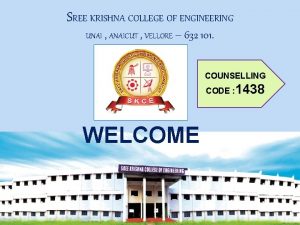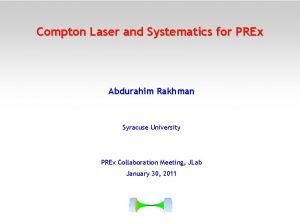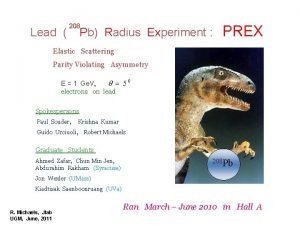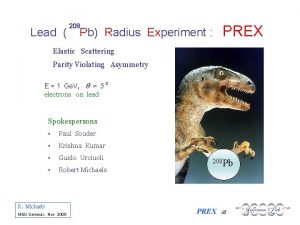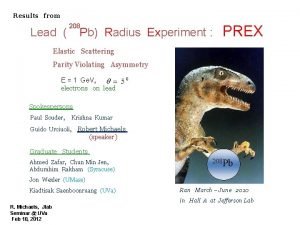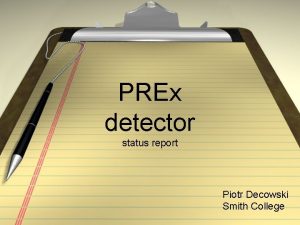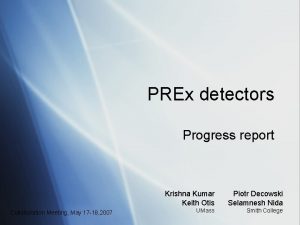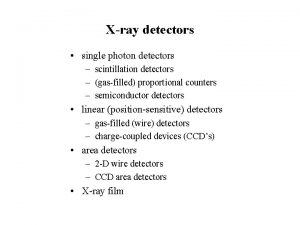Detectors for PREx Piotr Decowski Smith College Krishna














- Slides: 14

Detectors for PREx Piotr Decowski, Smith College Krishna Kumar. UMass Collaboration Meeting, April 17 -18, 2009

January 2008 test Statistics: 1 cm thick quartz�� Dustin’s analysis 0. 5 cm thick quartz�� Pedestal width = 1. 85 MPV = 25. 48 GSigma = 5. 65 Net width = 5. 34 (21%) Net RMS = 8. 57 (34%) (5. 34)2 = 28. 5 MPV = 14. 37 GSigma = 4. 59 Net width = 4. 20 (29%) Net RMS = 5. 49 (38%) (4. 20)2 = 17. 64 NPE = 1/(. 21)2 = 22. 7 NPE = 1/(. 29)2 = 11. 9

January 2008 test Absolute determination of NPE: NPE * (1. 602*10 -19 C)*PMTGain = MPV(ch)*(50*10 -15 C/ch) Le. Croy 1881 M ADC NEEDED!

Measurement of PMT gain Anna Boehle, Diana Jaunzeikare, Smith College 21 f. C/ch

Measurement of PMT gain, cont PMT: Hamamatsu R 7723 Q (fused silica window) PMT # ZK 40033: Gain @ -2000 V = 4. 384*105

Results 1 cm thick quartz�� 0. 5 cm thick quartz�� Statistics: NPE = 22. 7 NPE = 11. 9 NPE (1 cm)/NPE(0. 5 cm) = 1. 90 Absolute gain: NPE = 18. 1 NPE = 10. 2 NPE (1 cm)/NPE(0. 5 cm) = 1. 77 (exp) Note: without pedestal width subtraction statistics gives NPE(1 cm) = 20. 3, and NPE(1 cm) = 9. 8

GEANT 4 Simulations Jon Wexler, UMass Cone mirror Tube mirror PMT cathode Quartz block

Simulations: photon energy range PMT QE: 380 nm Alzak cut 185 nm Quartz cut Standard PMT QE cut 500 nm QE cut Alzak: reflectivity 93 - 98% Anodized Al reflectivity: 85 - 87%

Simulations: results 1 cm thick quartz�� 0. 5 cm thick quartz�� Sim: NPE = 26. 6 NPE = 13. 9 Stat: NPE = 22. 7 NPE = 11. 9 Gain: NPE = 18. 1 NPE = 10. 2 Simulations overestimate experimental results by ~ 30% (there is room for improvements!)

Simulations: Al vs Alzak 1 cm thick quartz�� 0. 5 cm thick quartz�� NPE = 26. 6 NPE = 13. 9 NPE = 64. 5 NPE = 34. 0 Alzak Al Improvement: factor 2. 4 !

HRS focal plane Bob Michaels

Detector concept Top view LED 10 cm Optimize Quartz 0. 5 cm (0. 25 cm) thick Al mirror tube 2” PMT Expected ~20 PE per PMT/electron (~4 n. A @1 GHz) Two stacked 0. 25 cm thick detectors?

A_T Detector configuration Det 2 Det 1 e- beam

Conclusions and plan 1. Simulations are reproducing experimental data well. 2. We have tool to optimize geometry of new detectors 3. with larger quartz accommodating larger footprint of the Pb elastic peak. 3. Use of anodized aluminum instead of Alzak and PMTs with fused silica window significantly increases number of PE’s. Plan for nearest future: 1. Construction of two prototypes of detectors with existing quartz blocks to test PE enhancement due to Al mirrors. These detectors will be used at the beginning of the HAPEX run. 2. Optimization of geometry of detectors with larger quartz blocks. 3. Construction of A_T detectors (similar to used in the January 2008 4. tests). 5. Construction of small plastic scintillator pads which will be mounted above the main detectors, and in counting mode will substitute S 0 detector.
 Sree krishna college of engineering vellore
Sree krishna college of engineering vellore Prex cold laser
Prex cold laser Alex prex
Alex prex Prex cold laser
Prex cold laser Alex prex
Alex prex Alex prex
Alex prex Streaming potential
Streaming potential Where are feature detectors located
Where are feature detectors located Giant wave detectors murmurs universe
Giant wave detectors murmurs universe Frontier detectors for frontier physics
Frontier detectors for frontier physics Photo detectors
Photo detectors Vhv voltage detectors
Vhv voltage detectors Kinesthesis and vestibular sense
Kinesthesis and vestibular sense Giant gravitational detectors hear murmurs across
Giant gravitational detectors hear murmurs across Diagnosing error in object detectors
Diagnosing error in object detectors
